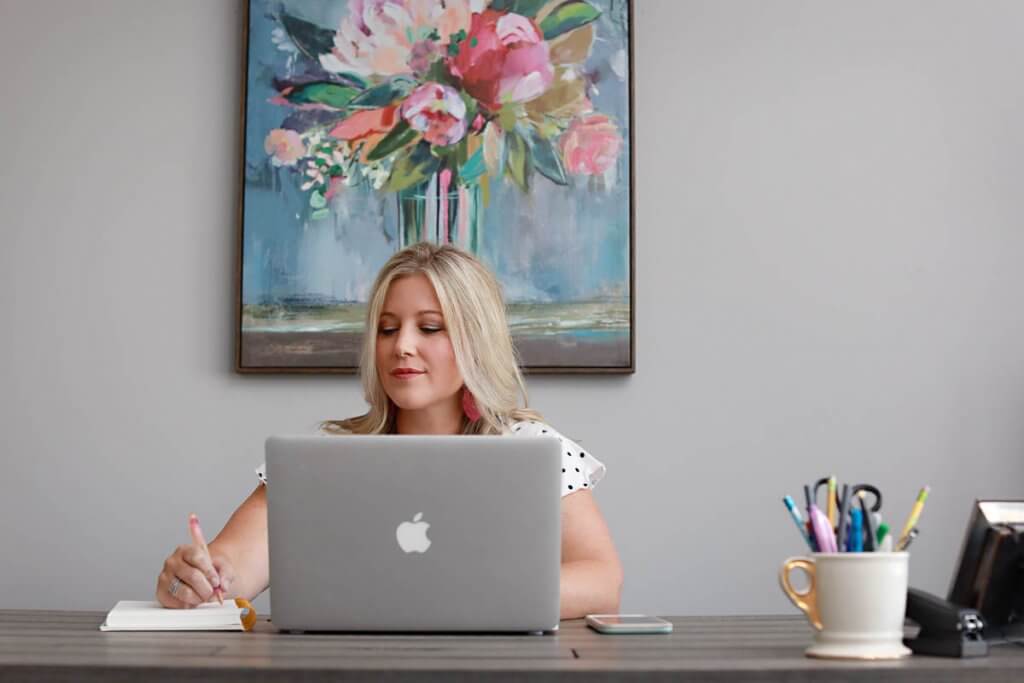How to Start a Blog
Many people want to start a blog but have no idea where to start. With the right resources, and a little encouragement, you can start your own and I’m going to share with you the basics of how to start a blog.
I am the co-founder of Spark Media Concepts and together, with my business partner Jennifer, I help people create the blogs they have dreamed of starting. It is THE BEST job ever. I love what I do and helping other people.
We have a FREE Blogging 101 Webinar coming up on 12/28 and I’d love for you to join us, click here to register!

Reasons to start a blog
- If you are active on social media, you don’t own your content.
- You have a story to tell.
- You want to help people.
- You want to meet new people.
- You will learn and grow.
- You want to make more money.
- You can work from anywhere.
- You want to grow your brand.
- You want a creative outlet.
The opportunities are endless… so what are you waiting for??
I want to help you with some basic blogging steps to get started, or just to educate yourself on what needs to happen in order to start.
How to start a blog
- Pick a niche for your blog
- Choose a blogging platform
- Purchase your domain name
- Purchase web hosting
- Install parent and child theme
- Design your blog
- Set up email marketing
- Learn SEO & keyword research basics
- Create content
- Share content on Pinterest & other social media platforms
1. Pick a Niche
Deciding what you are going to blog about can be one of the largest hurdles to overcome, but it’s an important step.
What is a niche?
A niche is when you have products, services, or interests that appeal to a small, specialized section of the population. Your niche is your blog topic and I recommend you narrow your niche when starting a blog so people have a clear understanding who you are, what you are going to help them with, what value you will offer and what they can expect.
For example, if you want to have a lifestyle blog (like many do) that’s totally fine, but you want to be sure you are being clear about what your content is going to be about. If you are all over the place talking about several different topics to start, your audience won’t really know if they want to connect or not.
Spend some time brainstorming different topics you’d like to discuss and narrow it down to 2-3 to start. Once you get established you can incorporate other content, but build your solid foundation first.
2. Choose a blogging platform
If you want your blog to grow, you likely want to be on WordPress.org, that is the free version of WordPress. There are a lot of blogging platforms to choose from, but if growth is your goal, WordPress.org is where you want to be. You are in total control and own all of your content on this platform, which is really important.
When you build your blog on WordPress.org you will also have to purchase your website hosting, parent theme and child theme, and I’ll go into more detail about each of those steps.

3. Purchase your domain name
You will need to choose a name for your blog. Once you decide on a name, you will purchase your domain name. You can purchase it on several different websites but the one I generally recommend is Namecheap.
Tips for choosing a domain name
- When choosing a domain you’ll want an extension that ends with .com or .net for most blogs.
- Make sure your website name is easily recognizable such as the correct spelling of a word. If it’s confusing to remember, people won’t remember it.
- Make it memorable. If it’s catchy and relates to your subject matter, it will be easier for people to remember.
- Research the name to make sure it’s not trademarked or is not connected to any other websites that could cause conflict with your business.
- Act quickly! If you find a domain name that you like, and it’s available, buy it! They go fast! I also recommend you auto-renew it so you don’t run the risk of losing it.
4. Purchase Web Hosting
Think about your website as a bunch of files. You need a place to store those, right? There’s no way you could store everything required in order to have a website (or at least not without some significant investment in equipment and knowledge).
That’s where web hosting comes in! There are companies out there in the business of having all the equipment necessary to host websites.
I’ve worked with a few different hosting companies and I highly recommend Big Scoots. Big Scoots is reliable, cost effective and they have excellent customer service. They go above and beyond to make sure your website performs well and if there is an issue they are quick to help you figure it out.
5. Install parent and child theme
Since you are on a self-hosted WordPress.org site, you will need a parent and child theme.
A parent theme is what you will need to install to give your website the functionality it needs. The parent theme I recommend is Kadence. It is free to download and install on your website and performs well. Here is a video on how to install Kadence.
Once you install your parent theme, you’ll need to purchase and install your child theme. For many years we have recommended Restored316 to our students in The Ultimate Blog Bootcamp. Lauren from Restored316 has created amazing and versatile themes that offer a great user experience and exceptional pre-made themes that you can use to create the look and feel of the website you want without paying the price for a custom site (that could cost you several thousand dollars).

6. Design your blog
Now that your child theme is installed you will want to design your site with all the necessary components. You will want to have the following on your blog
- About Me Page
- Contact Form
- Homepage
- Menus
- Categories
- Email Sign Up forms
When you are designing your blog think about the user experience. Does the user understand where to go and what they will get from your blog? Make it easy for them to navigate and use colors and fonts that are easy to read and visually pleasing as well.
7. Set up email marketing
Email marketing is how you will stay in contact with your readers. You will need to install a few email sign up forms on your site. I recommend having one in your side bar, on your homepage, and anywhere else it feels authentic and reminds them to connect with you.
You will use an email marketing service such as MailerLite or ConvertKit to set up this service on your blog, and this is a service you don’t want to skip!
Your email list is extremely important when building a blog. Nurture this list and be willing to do things to help it grow such as offering a freebie when they sign up, a webinar to get them on your list that will teach them something, etc.
Your email list is important because these are the people who are interested in what you have to say and what you are selling. They are priceless, so treat them as such!
8. Learn SEO & keyword research basics
SEO stands for search engine optimization and it is very important if you want to build a blog that will grow. Essentially SEO and keyword research is the art of figuring out what people are searching for and providing them the best possible resource to help them.
In our course, The Ultimate Blog Bootcamp, we go over the basics of SEO and keyword research and help people get a good feel for what it looks like to dive into this part of blogging. Many people feel intimidated by it, but don’t allow yourself to feel that way because it can be very beneficial (& profitable) once you get a good grasp on it!
Resources for SEO and keyword research are SEM Rush and you can also google “keywords everywhere” for a great extension to add onto your computer to help you with your research efforts as well.

9. Create content
Finally! This is the part you’ve been waiting for! Creating content is the fun part of blogging! And once you have all the initial set-up pieces figured out, this is where you’ll spend most of your time.
Tips for creating content
- Be consistent. 1-3 blog posts a week consistently is a great goal for growth. The more you post the better opportunity for growth (if content is good quality) but you have to stay realistic with what you can do long term.
- SEO & Keyword Research. If you want to grow, you will want to make sure you are creating content that people are actually searching for. It doesn’t mean you can’t ever write about anything else, but you’ll want to put a lot of effort here to ensure you are focusing on traffic growth.
- Serve your audience. You will learn what your audience likes, and what it doesn’t. Engage with them. Ask them what they need. Be willing to offer your experience and expertise and you’ll build a genuine and faithful community.
- Multipurpose your content. Don’t feel overwhelmed about how much content needs to be created, instead think of how you can repurpose it. Turn a blog post into several Instagram posts, an IG reel, a Pinterest pin, etc. Create one piece of content and use it in several different ways!
10. Promote your content on Pinterest & other social media platforms
After you create your content, you will want to make sure that you are sharing your content on Pinterest. When you share on Pinterest your content lives on indefinitely. Using Pinterest allows your content to continually circulate since you aren’t the only one who will be sharing it (that’s the beauty of it!)
Simple Pin Media is a great Pinterest resource if you want any additional insight on what to do next.
If you are active on other social media platforms share your post with your audience there as well! Direct them to your blog, remind them to sign up for your email list while they are there as well!
Ready to start a blog? I’d love to help!
Since 2017 I have been helping people start their own blogs via my business, Spark Media Concepts. While you can do it on your own, we know how much support people need along the way and my business partner, Jennifer, and I would love to help you.

We started Spark Media Concepts in 2017 because we knew there were people out there who wanted to blog, but didn’t know where to start… so we created a course to help them do so!
Our course The Ultimate Blog Bootcamp is unlike any other course with unparalleled support.
We not only give you a step by step plan for how to set up your blog, we also add in 8 weeks of live coaching calls and a private Slack group where we help our students. We love this space and our students and would love to connect with you if you’d like some help.
You can follow us on Instagram here and/or join the waitlist for the bootcamp here.
What blogging questions do you have??? Drop them in the comments!




